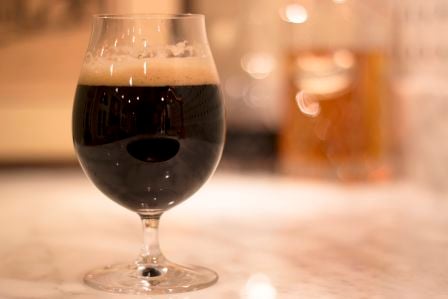
This week I take a look at how to carbonate your stouts using a stout mix of 70% nitrogen, 30% CO2 gas to get a smooth creamy head on your stout as well as its use in wines, mead and cider.
What is Stout Mix Gas?
Most home brewers use carbon dioxide (CO2) gas cylinders to carbonate and serve their beer. However, the famous Guinness stout as well as several other stout brands are not served with CO2 but instead use a nitrogen-CO2 blend and a special stout faucet for serving. This combination gives Guinness their famous creamy nitrogen head on the beer and a unique mouthfeel to the beer.
While you can carbonate and serve beers with regular CO2, you won’t achieve the creamy nitrogen head on the beer without using stout mix.
Stout mix, often also called “Guinness mix” is a mix of either 70% nitrogen and 30% CO2 or 75% nitrogen and 25% CO2. It is commonly sold by beverage gas supply shops in smaller 5 lb cylinders that are rated for nitrogen. Unfortunately you will pay a premium for this gas as it is more expensive to produce than regular CO2.
Equipment Needed for Serving with Stout Mix
Nitrogen is stored at a much higher pressure than CO2, so a stout mix cylinder has thicker walls rated for the nitrogen. To use one you will also need to purchase a nitrogen regulator, as the more common CO2 regulators are not rated for the higher pressure.
You will also need to purchase a stout or restrictor faucet, often called a stout faucet. These faucets typically have a restrictor plate which helps to force the CO2 out of solution at the higher pressure these beers are carbonated. Some stout faucets also have a “creamer” function which is activated by pushing the faucet handle back and results in additional agitation to form the white head on the beer.
So to server your stout with nitrogen you need a dedicated stout-mix filled gas cylinder, a nitrogen regulator and a specialized stout faucet. Since none of these are inexpensive, you can see why many brewers never choose to serve their stouts with a nitrogen mix.
Using Stout Mix in Practice
Nitrogen is very difficult to force into solution in beer, with only about 1/100th the solubility that CO2 has. Therefore most of the carbonation in your finished beer still comes from the 25% CO2 gas. Also stout mix is really only appropriate for low carbonation beers like stouts (1.2-1.9 volumes of CO2 carbonation level), because higher pressure levels will drive the CO2 into a liquid state leaving the beer flat.
So stout mix beer is carbonated and served at much higher pressures, usually about 4x the pressure used with conventional CO2 beers. When the beer is poured through the restrictor plate in the stout faucet and poured, small nitrogen bubbles are drawn down the side of the glass by convection while CO2 released by the plate bubbles up the center. This “cascade” effect gives draft Guinness a unique appearance when first poured.
To determine the appropriate pressure for carbonating your beer with stout mix, we remember that CO2 is typically 25%-30% of the mix, and nitrogen is only 1% of the carbonation level. So to achieve the same carbonation level as a typical CO2 beer we need to use about 4 times the pressure for a given temperature.
So for example lets look at a stout with 1.9 volumes of carbonation, served at 42 F (5.6 C). For a conventional CO2 beer you would use 6.6 psi (45.5 kpa) of pressure. Since we are using stout mix which has only 1/4 the CO2, we need to up the pressure by a factor of four so 6.6 pxi x 4 = 26.4 psi (182 kpa). So we would set the regulator on our stout mix tank to 26.4 psi (182 kpa) when carbonating and serving the beer at 42 F (5.6 C). For comparison, Guinness serves at around 40 F (4.4 C) using a keg pressure of around 30 psi (206 kpa).
Other Uses for Stout Mix in Wines, Meads and Cider
This is not well known, but stout mix is also a good mix for topping off and serving still wines, ciders and meads. I personally have served wines and meads for many years directly from kegs using stout mix. Typically I will only set the regulator to 1-2 psi, which is just enough to force the wine or mead out of the keg.
The reason to use stout mix is that it is better than either CO2 or nitrogen alone. If you use nitrogen it will strip the wine or mead of its remaining CO2 and carbonic acid which changes the flavor balance of the wine, often in a negative way. Similarly using CO2 tends to increase the CO2 content of the wine or mead, creating additional carbonic acid and eventually altering the flavor balance.
Dedicated tap systems to serve wine off a tap use an adjustable CO2-Nitrogen mixer to counter the problem mentioned above. The mix is set depending on the temperature that the wine is served at to maintain the native CO2 balance in the beer. However low pressure stout mix is not that far off the ration you would typically use when serving still wines, so it is my choice for kegging still meads, wines and ciders at home. In this case you can use a traditional tap to serve the wine since it is done at minimal pressure.
I hope you enjoyed today’s article on using stout mix for your beers as well as meads, wines and ciders. Please subscribe for regular weekly delivery, and don’t hesitate to leave a comment or send this article to a friend.